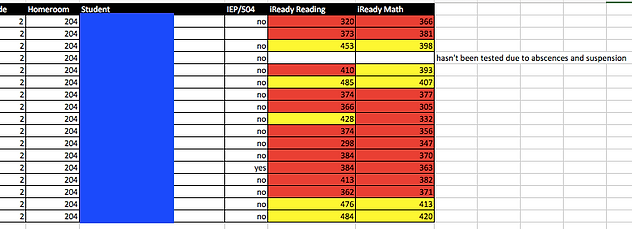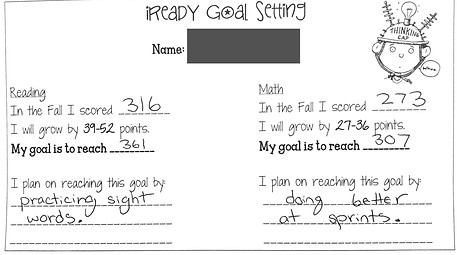Johanna Busch
I-Ready
I-Ready Reading and Math is the primary long term standardized assessment my school uses to evaluate student growth. My students take both I-Ready Reading and Math three times a year. I use data from I-Ready to inform decisions about small group instruction, monitor progress, and engage students in their own growth. Because students take I-Ready multiple times a year in all grades at my school, engaging students around I-Ready allows me to set and measure progress towards long term goals. While tracking data on other assessments engages students in their own growth on a weekly or unit-long time scale, I-Ready is a long-term goal. The long-term nature of this assessment motivates students and and allows me to monitor student progress over a period of months to better inform my instructional decisions.

The above spreadsheet shows beginning of the year I-Ready Reading and Math data. Students are classified as green if they are on or above grade level, yellow if they are one grade level below, and red if they are two or more grade levels below. In reading, 45% of my students were one grade level below. 55% of my students were two or more grade levels below in reading. In math, 10% of my students were on or above grade level. 24% of students were one grade level below, and 66% of students were two or more grade levels below. These assessments show that most of my kids are below grade level in both math and reading. This means that I need to provide my students with extra instruction in foundational skills for them to demonstrate growth.
Data Analysis for Small Group Instruction
I primarily use I-Ready to inform small group math instruction. Beginning of year I-Ready data is used to create initial small groups. I-Ready suggests small groups based on which students have similar skill deficits. I adjust these based on my own assessments and observations. I then use I-Ready data to inform what I work on with these students during small group math lessons. I-Ready has lesson plans and activities suggested for students from each skill profile. I use these to make sure students are building the foundational skills that they were missing on the beginning of the year test.

This is a screenshot of the math instructional groupings generated by I-Ready. Because none of my students were on grade level at the beginning of the year, I-Ready only put students into two groups. I use this data as a starting point for creating math small groups.

This is the powerpoint slide I project with math center groupings. I used the groupings generated by I-Ready as well as my own observations and assessment data to create four groups. I keep the grouping chart on powerpoint so that I can easily change the groupings based on new data. Students constantly move up and down groups based on current assessment data.
In addition to guiding my decisions in how I group students, analysis of I-Ready data also helps me decide what skills to work on with each group. I-Ready generates a list of teacher recommendations for each instructional group based on students strengths and deficits in each domain. I use these recommendations to plan goals for each center group and to plan how I will teach skills to each group.
Below is a portion of an I-Ready report that shows recommendations for teacher led instruction for students in Grouping 2. According to I-Ready, theses students are struggling with quantitative reasoning skills such as modeling addition or subtraction using place value of relating addition to subtraction. Based on these skill gaps, I-Ready recommends a variety of skills to focus on in each domain. I create small groups lessons or center games for students in this profile based on these recommendations. For example, this report suggests that students should practice reading numbers in both standard form and place-value form. Based on this recommendation, I created a center game that required students to roll two or three digit numbers and write them in different forms.
Progress Monitoring
The long term nature of I-Ready allows me to use it to monitor my students' progress. I use I-Ready to monitor student progress by analyzing I-Ready lesson data and the middle of year I-Ready assessment. These tools allow me to monitor whether or not students are on track to meet their growth goals. I use this information to make adjustments to center groupings and instructional plans.
Students complete assigned I-Ready lessons on laptops one day a week during small group math time and at home, if they are able. These lessons teach students key skills but also assess their mastery of these skills. I-Ready reports show student progress in each domain. These reports show me the progress each student is making towards grade-level in each domain. I am able to view student scores on specific lessons and monitor their progress in each of the four math domains.

This is a screenshot of a domain progress report for a student who tested on a mid-kindergarten level at the beginning of the year. This student's scores on I-Ready lessons demonstrate that he is now almost at a first grade level in the Measurement and Data domain.
Analyzing results from the middle of year I-Ready assessment is another way that I monitor student progress.
After the middle of the year I-Ready test, I analyze data, identify bubble students, and plan for how I'm going to support students of varying profiles in each domain before the end of year test. I analyze this data with the help of my instructional coach and fill out a worksheet that is turned in to my principal. This process pushes me to not just look at overall scale scores but to deeply analyze the data by domain and look at progress made by individual students in specific domains.
This document is an I-Ready data analysis worksheet that I created with the assistance of my instructional coach. It identifies students who are close to moving from yellow to green or red to yellow. It also lays out instructional strategies for each math domain based on my whole class's data.
Student Engagement
Building student engagement around I-Ready is key for student success. Students need to understand what I-Ready is measuring and what it tells them about their own growth as mathematicians and readers. One way I do this is by discussing data with students after each benchmark assessment.
Data conferences are another way that I engage students in their own growth. After each I-Ready testing period (beginning, middle, and end of year), I have goal setting conferences with each student. I write all the students' data on goal setting sheets and find time during center or independent work time to complete the goal setting sheets with students. During the conference, I show students their I-Ready data. I tell them and write down their goal score for the end of the year. We then discuss strategies for meeting this goal. Students choose one reading and math strategy that is recorded on the conference sheet. The sheet is sent home to keep parents up to date as well. Goal setting conferences help students gain a better understanding of their current academic abilities, long term goals, and what they need to do to reach these goals, engaging them in their own growth.

This is a picture of a data conference I held with a student to discuss her I-Ready Beginning of Year data. I engaged this student in her own growth by showing her results on my computer, recording goal scores on the below sheets, and asking her what she thought she needed to do to reach these goal scores.


This is the conference sheet of a student who is almost on grade level in reading and math. This student was very encouraged by how close he was to reaching green. He decided that he wanted to try to reach grade level by the end of the year by reading more and practicing math flashcards.
This is the conference sheet of a student with an IEP who is two grade levels below in reading and math. This student is often very overwhelmed in class. Our data conference gave us a chance to discuss achievable goals, such as improving her scores on sprints and sight word recognition. Breaking down a huge growth target into manageable chunks helped this student engage in her own growth and feel capable of growing.
After these conversations, students have the opportunity to move their clip up on our class I-Ready data charts. These charts are a daily reminder of students' potential for growth and remind students to be proud of everything that they have achieved. I often find my students studying this I-Ready chart. This chart is a daily reminder for students of where they are now, where they want to be, and how they can get there.
This is a picture of our class I-Ready math tracker. Each clip has a student's name on it. Students move their clips up the flower stem as they demonstrate growth on I-Ready.